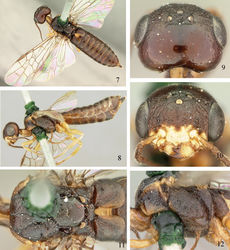Euxiphydria leucopoda
| Notice: | This page is derived from the original publication listed below, whose author(s) should always be credited. Further contributors may edit and improve the content of this page and, consequently, need to be credited as well (see page history). Any assessment of factual correctness requires a careful review of the original article as well as of subsequent contributions.
If you are uncertain whether your planned contribution is correct or not, we suggest that you use the associated discussion page instead of editing the page directly. This page should be cited as follows (rationale):
Citation formats to copy and paste
BibTeX: @article{Smith2011JournalofHymenopteraResearch23, RIS/ Endnote: TY - JOUR Wikipedia/ Citizendium: <ref name="Smith2011Journal of Hymenoptera Research23">{{Citation See also the citation download page at the journal. |
Ordo: Hymenoptera
Familia: Xiphydriidae
Genus: Euxiphydria
Name
Euxiphydria leucopoda Takeuchi – Wikispecies link – Pensoft Profile
- Euxiphydria leucopoda Takeuchi 1938[1]: 183, fig. 2.
- Hyperxiphia leucopoda: Maa 1949[2]: 39.
Diagnosis
Length, 9.0–12.0 mm. Head orange, except medial black stripe on vertex extending anteriorly through ocelli and anterior to ocelli as an inverted V (Figs 3, 4). Antenna dark brown with scape and pedicel reddish; Thorax black with tegula, anteroventral quarter and narrow posterior margin of pronotum white (Figs 2, 5). Abdomen black with white spot laterally on eighth tergite (Fig. 1). Legs entirely white to yellow except apex of apical tarsomeres brownish (Fig. 2). Wings hyaline, veins and stigma black (Fig. 1). Antenna with 13 antennomeres; length of first four antennomeres as 1.0:0.4:0.8:0.5. Frons sculpture reticulate, especially around and anterior to ocelli (Figs 3, 4). Head from above strongly narrowing behind eyes, distance behind eye less than eye length (Fig. 3). Malar space between eye and antennal groove much narrower than groove. Axilla and mesoscutellum with irregular longitudinal carinae; lateral and posterior downturned areas smooth and shiny (Fig. 5). Hind basitarsomere slightly longer than length of remaining tarsomeres combined. Lengths of sheath and basal plate subequal. Male unknown.
Distribution
Japan: Honshu; Shikoku (Togashi 1974[3]).
Specimens examined
Holotype. Female, labeled "19,VII,1920, Daisen, Takeuchi," "Euxiphydria leucopoda Takeu., Holotype" (OPU). Takeuchi (1938)[1] stated July 15 in the original description but it appears to be "19" on the label. “Mt. Haku, 5/VIII.1968" (1 ♀, USNM, identified as Euxiphydria leucopoda by Togashi).
Discussion
Euxiphydria leucopoda was transferred to Hyperxiphia by Maa (1949)[2] without explanation, but it is actually an Euxiphydria as described by Takeuchi (1938)[1]. Euxiphydria leucopoda has three labial palpomeres with the third clavate and four maxillary palpomeres, as well as other characteristics of Euxiphydria except for the head which is short and narrowing behind the eyes in dorsal view. Hyperxiphia has three labial palpomeres of equal width and has five maxillary palpomeres. The holotype is a small specimen, about 9 mm long. The specimen from Mt. Haku is 12 mm long.
Takeuchi (1938)[1] described a variety, Euxiphydria leucopoda var. nakanishii, which he stated to be similar in structure to the typical, but smaller, the hind basitarsomere distinctly shorter than the following tarsomeres together, and differing in color with the head entirely black except for pale yellow below the antennae. This is actually a different species and genus and was correctly placed in Hyperxiphia by Maa (1949)[2]. The holotype is at OPU and is labeled “8,VIII,1938, Daisen,Takeuchi,” “Euxiphydria leucopoda nakanishii Tak., Holotype.” It has not been illustrated; therefore, we provide Figs 7–12 for its recognition and comparison with Euxiphydria leucopoda.
Taxon Treatment
- Smith, D; Shinohara, A; 2011: Review of the Asian wood-boring genus Euxiphydria (Hymenoptera, Symphyta, Xiphydriidae) of hymenoptera research/ Journal of Hymenoptera Research, 23: 1-22. doi
Other References
- ↑ 1.0 1.1 1.2 1.3 Takeuchi K (1938) A systematic study on the suborder Symphyta (Hymenoptera) of the Japanese Empire (I). Tenthredo 2 (2): 173-229.
- ↑ 2.0 2.1 2.2 Maa T (1949) A synopsis of Asiatic Siricoidea with notes on certain exotic and fossil forms (Hymenoptera Symphyta). Musée Heude, Notes d’Entomologie Chinoise 8: 11-186.
- ↑ Togashi I (1974) Symphyta of Shikoku, Japan (Hymenoptera). Transactions of the Shikoku Entomological Society 12: 13-22.
Images
|

